|
A Bristolian Train Driver Recalls WW II By Marc Nussbaumer The Second World War has proved Britain’s railways to be of vital strategic importance to the British and Allied Nations’ cause. Their achievements have reflected the courage and vision of the 600,000 railway workers who ran them. This article pays tribute to those who, in spite of wartime difficulties, upheld the tradition of a great service.
“In 1940 I was called up, having to go to Salisbury. My company, the Great Western Railway (GWR), gave me a letter to take to the medical exam. The newly formed Railway Executive decided that I would be eligible for Transportation Units of the ROD (Railway Operating Division) of the Royal Engineers. “
The Minister of Transport had taken control of the nation’s rail transport and British railways immediately had to switch over from a peaceful network controlled by four companies to a highly complicated war-time system. To meet the challenge the railwaymen could rely on a hundred years of experience. As they were used to planning and preparing against breakdowns, derailments and storms, they were ready to face the acts of the enemy and to meet the Governments’ requirements in terms of population, troop and freight transport. Like most of the footplatemen Ronald speaks about the locomotives he used to drive as if they had been human beings. His “locos” had to fulfil unusual missions. Those used to pull passenger trains were then hauling troop trains and war freights. On the GWR most freight engines recorded 1,500 miles between Mondays and Fridays. Ronald is still upset about the amount of hardship inflicted on his machines:
“As the war progressed, passenger locomotives were pressed into freight work, unheard of with the GWR. Likewise the mileage of locos was greatly increased between shopping (going to Swindon) for complete overhauling and repainting. You can imagine the state they got in, repairs being put back till they were stopped for boiler washing out, for example. Frequently they were put on to fresh work without going into the shed for servicing, and worked till the tender was empty of coal or sent into a depot somewhere to be coaled and then carried on. You had to see the state the fires got in, firebox full of clinker, and frequently one had to stop and have a blow up to regain a full head of steam again. Engines became common users, and any depot could collar them, only returning to their home depot when repairs and boiler washing was an urgent necessity.”
There were growing demands for more and more motive power. Engines were exchanged between the railway companies and drivers were transferred temporarily from one railway to another. As a result firemen were working alongside drivers coming from other railways. In time of war the nation’s interest took precedence over industrial competition. 2-8-0 heavy freight engines in stock, which had been produced by LNER (London and North Eastern Railway), were quietly reinstalled. Hundreds were sent to the front line in France and the Middle East. As a consequence, classes of engines that had been phased out had a new lease of life. American forces brought their own material. They handled the equipment with clockwork precision as if they worked on an assembly line. Ronald was impressed by their organisation, which was based on machine time rather than on human factors:
“We also had American engines that were shipped into Avonmouth, assembled there and we had them in Bristol until they went to France. When US manpower assembled open wagons and box cars it seemed to be a matter of minutes. A mobile crane placed bogies on the rails and then prefabricated boxcars or wagons were put on them. This went on day and night. When the invasion had moved inland the traffic increase became more noticeable. Petrol and oil trains left Avonmouth for the London area and the South East. But at the same time a pipeline was being laid to London, and when in full flow, these trains ceased running.”
The American strictness could even been verified in the way they handled the prisoners of war:
“When the Americans operated POW trains, there seemed to be as many guards as prisoners. The place literally crawled with them, around the station and along the train. What a contrast to what seemed to me our casual approach when dealing with these trains.”
The British railways were moving extra food supplies and equipment essential for the logistics of conflict. The volume of traffic was growing but the supply of new equipment to handle it was not available and there was a shortage of adequate labour. To cope with these difficulties, quicker turnround was ensured. Goods depots were kept open at weekends whereas loading and unloading work was reorganised. Ronald was particularly amazed at the heavy tonnages of coal being carried from the collieries:
“The number of express freight trains expanded out of all proportions. Many stations had loop lines built at them (refuge sidings made into loops). They were dealt with at their various destinations, so they all moved forward from loop line to loop line, station to station, constantly fed en route by other trains. Coal came out of South Wales in unimaginable quantities. The 4½- mile long Severn Tunnel never cleared of smoke and exhaust steam despite the huge fans housed in there to clear them.”
Rail travel was not restricted, but people were asked though posters to consider what was really important with questions like “is your journey really necessary?” or “Food, shells and fuel must come first. Do you mind?”
Ronald recalls the difficulties linked to the running of these overcrowded trains:
“The too few passenger trains were heavily loaded. Engines were not efficiently serviced and inappropriate coal was used. We never received the class of coal our engines were built for, and that made things more arduous for us. One just shovelled and shovelled it in until the tender was empty, frequently stopping to fill the firebox up before starting off again. It was a backbreaking, frustrating job to keep them running, especially the night sleeping car trains. They were always full to bursting point with corridors full of sleeping forces personnel.”
The Railways were moving troops and their equipment by special trains by day and by night. As fighting services expanded rail transport became more and more exacting. Many trains had to be scheduled at short notice. For example, after the evacuation of Dunkirk in 1940, 620 trains carrying 300,000 troops were run without prior knowledge of their arrival from the different ports of southeast England. The arrival of the American Expeditionary Forces with their equipment and supplies added to these movements by rail, and by the summer 1942 special trains were running at a rate of 5,000 per month above the ordinary traffic. Ronald recalls that the number of troop trains even increased in the period preceding D-Day, when thousands of American soldiers came into South Wales ports and travelled to the southern harbours.
Other unscheduled trains were given even more attention. Very often intimation was received at Traffic Headquarters that special vehicles had to be moved. Only a few railway-operating officials knew the true character of the train and its destination. Control offices, stationmasters and signalmen on the line of route were only advised of the arrangements at the very last moment. Among the many trains he had to drive during the war, the `Ghost train´ especially puzzled Ronald. Little was known on this luxury train that had right of way over all other train vehicles:
“This train, which was stationed at Bristol, was composed of five Pullman cars and constantly manned. High ranking personal, ministers, etc. of England, the USA and Canada would fly into Whitchurch, Bristol’s airport, and then take the train from Temple Meads to Paddington. All other trains were stopped or recessed to let us by. There was even a special bell code to announce the “Ghost train”. “
Britain’s railways had to tackle the biggest job in transport history. However great the pressure they had not only to operate their ordinary services but also to run a tremendous number of additional passenger and freight trains, to carry troops, to evacuate people and sometimes to re-evacuate them from locations of refuge that had become vulnerable. As one author points out: “The more one studies this story the more one is struck by the fact that the railways can always take a little more in their stride” (Bernard Darwin, War on the Line, 1946). The railways’ mission was even more difficult during the air raids. The enemy used to attack the railways deliberately in order to put them out of action and so disorganising the country’s war effort and the national life. However, the British did never lose their legendary phlegm, especially as war progressed. Wartime blackout regulations were not always respected. When an air raid siren sounded and the location of the nearest air raid shelter was announced at the station, most people stayed on the train during the alert. In fact, as most trains were overcrowded, passengers were afraid that they would lose their seat. For railway workers the alert also became routine, as Ronald puts it:
“At the commencement of hostilities small blue lights lighted stations, and everything stopped when air-raid warning red was received. But as the war advanced, little heed was taken of the red warning and work proceeded apace. Indeed in Paddington with a full-blown blitz in progress, when anti-craft firing was directly overhead, we were only sheltering in our engine cab.”
However, many locations became really too unsafe when German planes were droning overhead:
“Avonmouth when the blitzes were at full strength or indeed at any other time – as it was one of the largest parts on the western side for importing oil and petrol from the USA – there were three massive freight yards there with shunting engines, working 24 hours a day, seven days a week. Believe me it was a most unsafe place to be in the middle of these huge storage tanks, especially after nightfall. We lost many men down there, and as the war progressed, if enemy bombs were heading that way, smoke canisters were set alight and everything was then blacked out.”
As early as 1941 the Ministry of Home Secretary called the attention of the nation to the possibility of the enemy resorting to gas attacks, and to the importance of everyone carrying their gas mask and being able to put it on correctly and quickly. Ronald recalls the safety measures taken at GWR:
“Right from the onset we were equipped with steel helmets and industrial gas masks. We were expected to wear it periodically whilst on duty to accustom us. All locomotives had a portion of the cab eyeglasses painted with anti-gas paint, which would change colour if ran into a contaminated area.”
In addition to war hazards, railway workers had to face a low standard of living. Between 1939 and 1945 as the cost of living increased by 29%, the railway unions negotiated seven pay rises. Working time increased with the tempo of the war. Owing to excessive hours being worked, footplate staff and guards were given extra bread and extra cheese, above the ordinary civilian rations. And once a month they also received a quarter pound of tea, a can of milk and extra soap. Catering facilities were also provided, which made life more bearable in that period of rationing:
At that time staff canteens were being opened everywhere in big stations. The five in Bristol were opened 24 hours a day. We could bring our wives to have a mid-day cooked meal, sweet and all, and this really helped our rations out. On the whole, in the later part of the war things went better.
Sometimes Ronald was lucky to receive some extra rations from American soldiers:
“Towards the end of war G.I.s were everywhere. The whole of southern England was a huge depot. In every field were tanks, lorries, cars, ambulances, stores, ammunition, etc. Two weeks before D-Day American troop ships were coming into Swansea, they were loaded into trains, and all came through Bristol, and we worked them forward to Eastleigh and Southampton where they detrained, and we returned to Bristol again, engine and coaches back to Swansea, and this went on day and night for almost a fortnight. I’ve had packets of cigarettes, packets of soup powder, coffee, sugar, playing cards, books, and whole unopened packs of rations. They contained everything, even toilet paper. What a Godsend that was to us.”
Even Italian POWs contributed to improve the British fireman’s standard of living! Ronald can not understand how these prisoners managed to “do business” in a foreign country where most foods and clothes were rationed.
“At Bath Road Bristol, the huge passenger engine depot where I was stationed in 1943, we had a coach load of Italian POWs come in each day. They cleaned one engine daily and I’ve never seen such a mob in my life. They were as happy and singing as could be and always wanting to enter into conversation with us. Indeed, before long they seemed to have the run of the place, and how it came about they started selling us elastic; our wives could not get any in the shops. Cigarette lighters, combs, mirrors, etc. …Where they got it all from I don’t know. A few liked to argue politically. They were out of the war, well fed, and seemed really happy with their lot.”
Ronald also recalls an anecdote about the shortage of an intrument that was – and still is - essential to railway workers:
“We could not get alarm clocks and men were getting late on duty, their excuse being the absence of clock. So the government bought thousands from Canada, and they were distributed through application to our trade unions. In fact unionists gave us a document to purchase one of these clocks from a jeweller.”
If Ronald will never forget the dramatic moments of war, nor will he forget some emotional moments which enhanced the people’s courageous spirit:
“I recall one night at the canteen of Paddington at the height of a blitz. In one corner a sailor was playing the accordion, sitting on a pile of wooden beer bottle crates. We were all singing away despite the hell which was going on outside. As if nothing special happened.”
After V-Day, as if nothing special had happened, Ronald went on driving to and from Bristol, through nationalisation, electrification, reorganisation and dismantling. Nothing could stop a footplateman. Not even the Blitz.
Marc Nussbaumer - Marc.Nussbaumer@univ-nancy2.fr |
|
|
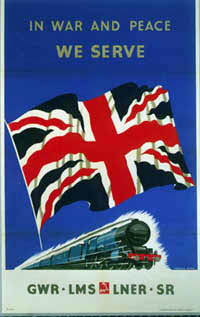 Ronald H. is one of these men whose devotion to duty helped railways to meet all demands made upon them. His account is of great value as few eyewitnesses are still alive or able to relate what happened during wartime. Ronald retired in 1982 after nearly half a century dedicated to the railways. He began his career in 1935 as an engine cleaner at Andover and was promoted to fireman at Swindon three years later. “You had to go where they sent you,” he says. When the war broke out Ronald was mobilized:
Ronald H. is one of these men whose devotion to duty helped railways to meet all demands made upon them. His account is of great value as few eyewitnesses are still alive or able to relate what happened during wartime. Ronald retired in 1982 after nearly half a century dedicated to the railways. He began his career in 1935 as an engine cleaner at Andover and was promoted to fireman at Swindon three years later. “You had to go where they sent you,” he says. When the war broke out Ronald was mobilized: 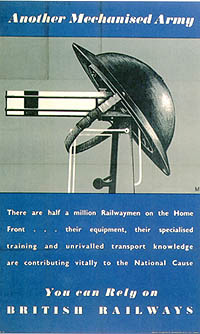 Railway traffic was increasing day after day to such a point that the forces had to return the enlisted railway footplatemen to keep traffic moving. Railway work was a “reserved occupation”, essential to the war effort. That is why Ronald was needed at “home”.
Railway traffic was increasing day after day to such a point that the forces had to return the enlisted railway footplatemen to keep traffic moving. Railway work was a “reserved occupation”, essential to the war effort. That is why Ronald was needed at “home”. 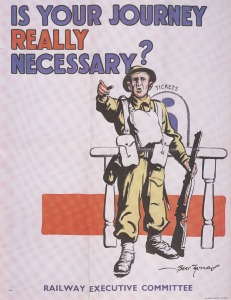 Absolute priority was given to Service movement and to workers travelling to and from the factories. Schemes were set up for the staggering of working hours to provide even more movement of workers. To increase passenger-carrying capacity and to discourage inessential travel, seven hundred restaurant cars were withdrawn and the sleeping-car accommodation on some heavily loaded trains was taken over by the Ministry of War Transport for the use of passengers travelling on urgent Government business.
Absolute priority was given to Service movement and to workers travelling to and from the factories. Schemes were set up for the staggering of working hours to provide even more movement of workers. To increase passenger-carrying capacity and to discourage inessential travel, seven hundred restaurant cars were withdrawn and the sleeping-car accommodation on some heavily loaded trains was taken over by the Ministry of War Transport for the use of passengers travelling on urgent Government business. 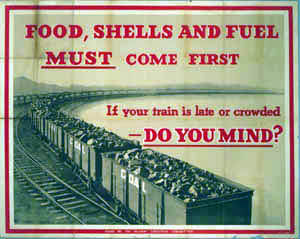
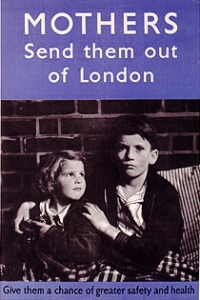 Additional trains had also to be run to move the great armada of children out of the major cities that were under the threat of being bombed. Children living in highly populated areas (London, Manchester, Merseyside, Newcastle, Birmingham) were evacuated to safer areas of rural Britain. Posters were to be seen all over the capital city advising “Mothers, send them out of London!”
Additional trains had also to be run to move the great armada of children out of the major cities that were under the threat of being bombed. Children living in highly populated areas (London, Manchester, Merseyside, Newcastle, Birmingham) were evacuated to safer areas of rural Britain. Posters were to be seen all over the capital city advising “Mothers, send them out of London!” 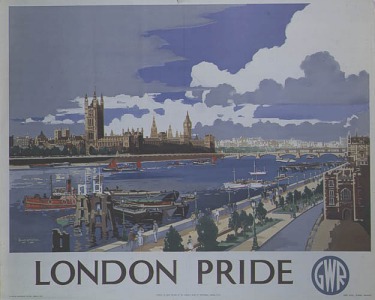 In the post-war period, when the railways began to return to normal, posters published by the GWR included views of London and Plymouth which showed the two cities in their pre-war state. As if nothing special had happened. Only later was it acknowledged that the strength and magnitude of the railways’ united war effort had been essential. Under difficulties unparalleled in history, railway workers had continued to meet all ordinary and extra demands made upon them.
In the post-war period, when the railways began to return to normal, posters published by the GWR included views of London and Plymouth which showed the two cities in their pre-war state. As if nothing special had happened. Only later was it acknowledged that the strength and magnitude of the railways’ united war effort had been essential. Under difficulties unparalleled in history, railway workers had continued to meet all ordinary and extra demands made upon them. 


